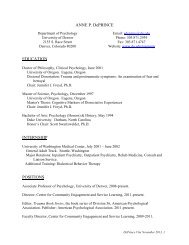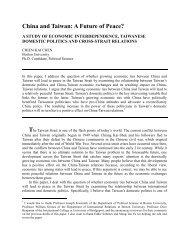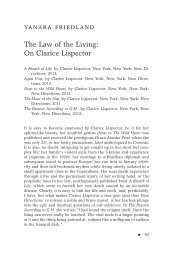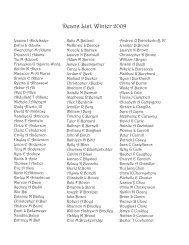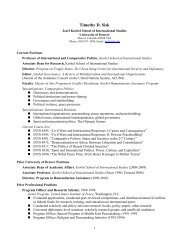Through a Speculum That Shines: Vision and Imagination in ...
Through a Speculum That Shines: Vision and Imagination in ...
Through a Speculum That Shines: Vision and Imagination in ...
Create successful ePaper yourself
Turn your PDF publications into a flip-book with our unique Google optimized e-Paper software.
History of Religions Feb 1997 v36 n3 p265(10) Page 4<br />
<strong>Through</strong> a <strong>Speculum</strong> <strong>That</strong> <strong>Sh<strong>in</strong>es</strong>: <strong>Vision</strong> <strong>and</strong> <strong>Imag<strong>in</strong>ation</strong> <strong>in</strong> Medieval<br />
Jewish Mysticism.<br />
God <strong>and</strong> Israel so that both of them can be her lovers, free<br />
to be fully passionate without any fear of homoerotic<br />
stirr<strong>in</strong>gs. Wolfson <strong>and</strong> I agree that this shared fem<strong>in</strong><strong>in</strong>e<br />
"partner" allows for the simultaneous <strong>and</strong> sympathetic<br />
sexual arousal of the male God <strong>and</strong> His aroused<br />
worshiper.(13) But his perception of shekh<strong>in</strong>ah as<br />
transparent, ever po<strong>in</strong>ted toward its manifestation as the<br />
tip of "the div<strong>in</strong>e phallus," would <strong>in</strong>dicate either a failure of<br />
this move or a suggestion that from the start it was an<br />
apologetic device to hide Kabbalistic homoeroticism. I see<br />
no warrant for either of these read<strong>in</strong>gs.<br />
The higher sefirot are also not given their due <strong>in</strong> Wolfson’s<br />
treatment. Particularly lack<strong>in</strong>g is consideration of tif’eret,<br />
the male God figure associated with the blessed Holy One<br />
of rabb<strong>in</strong>ic tradition <strong>and</strong> the erstwhile tw<strong>in</strong> <strong>and</strong> current<br />
suitor of shekh<strong>in</strong>ah. By focus<strong>in</strong>g on the union between the<br />
n<strong>in</strong>th <strong>and</strong> tenth sefirot, Wolfson gets an exaggeratedly<br />
genital picture of the male/female union of the sefirot. Had<br />
he selected the tif’eret rather than the yesod passages <strong>in</strong><br />
the Zohar, he would have seen more of a face-to-face or<br />
"person-to-person" union than one so entirely focused on<br />
genitality. It is furthermore clear that Kabbalists throughout<br />
history gave primacy to the union of the sixth <strong>and</strong> tenth,<br />
rather than the n<strong>in</strong>th <strong>and</strong> tenth, sefirot.(14) The reader of<br />
Wolfson who is aware of the abundance of these other<br />
materials(15) cannot escape the uncomfortable conclusion<br />
that his focus is distorted, perhaps overly shaped by his<br />
early studies of circumcision <strong>in</strong> the Kabbalah, or else<br />
driven by the particular Irigarayan <strong>in</strong>terpretive framework<br />
he has decided to impose.<br />
If these reservations about the Wolfson thesis are serious<br />
with regard to his Zohar read<strong>in</strong>gs, they are considerably<br />
stronger when applied to his attempts at read<strong>in</strong>g earlier<br />
texts, <strong>in</strong>clud<strong>in</strong>g both midrashic <strong>and</strong> merkavah passages,<br />
from the same phallocentric perspective. The list of such<br />
passages beg<strong>in</strong>s with his <strong>in</strong>terpretation of the s<strong>in</strong> of<br />
Aaron’s sons who "feasted their eyes upon the Presence"<br />
<strong>and</strong> the sh<strong>in</strong><strong>in</strong>g of Moses’ face after the vision on the<br />
mount as a displaced reference to "the disclosure of the<br />
male organ, perhaps <strong>in</strong> an ejaculatory state" (pp. 42-43).<br />
Wolfson provides no conv<strong>in</strong>c<strong>in</strong>g basis for such a read<strong>in</strong>g.<br />
His assumption (p. 85, n. 50) that the term yofi (beauty)<br />
when applied to God <strong>in</strong> a midrashic source refers to "the<br />
nakedness of the genitals when exposed dur<strong>in</strong>g a sexual<br />
act" is similarly without sufficient support.(16) The same<br />
goes for his read<strong>in</strong>g of sources from the obscure `Iyyun<br />
circle of mystics (pp. 281 ff.), where he applies the notion<br />
of phallic gaze not to the lowest of the sefirot but to the<br />
emergence of keter <strong>and</strong> hokhmah, the most primordial <strong>and</strong><br />
recondite of the div<strong>in</strong>e powers. He does not tell the reader<br />
that there is no tradition with<strong>in</strong> Kabbalah that applies<br />
genital symbolism here; it is Wolfson himself, apparently,<br />
who has decided that the primordial ether broken through<br />
(as def<strong>in</strong>ition first beg<strong>in</strong>s to appear with<strong>in</strong> the Godhead)<br />
can be noth<strong>in</strong>g other than a vag<strong>in</strong>a penetrated by a<br />
you-know-what.(17)<br />
Because of these objections, cumulatively as well as<br />
<strong>in</strong>dividually, <strong>and</strong> because I am not an <strong>in</strong>itiate <strong>in</strong>to what<br />
seems to be the new text-transform<strong>in</strong>g Kabbalah of Luce<br />
Irigaray, I have difficulty <strong>in</strong> accept<strong>in</strong>g Wolfson’s conclusion<br />
that "the development of Jewish mysticism . . . can be<br />
seen as the move from an implicit to an explicit<br />
phallocentrism" (p. 395). I do see the erotic as central to<br />
Kabbalah; I also recognize the phallic as a key symbol<br />
with<strong>in</strong> the Zohar. But Wolfson’s gaze <strong>in</strong>to this symbol has<br />
been extended too far. While this book rema<strong>in</strong>s, <strong>in</strong> my<br />
view, the most important work on Kabbalah by an<br />
American scholar, it is a major work significantly marred by<br />
this s<strong>in</strong>gularity of perspective, <strong>and</strong> thus one that must be<br />
used with caution <strong>in</strong>sofar as it deals with this central<br />
subject.<br />
In a reveal<strong>in</strong>g bit of methodological discussion that takes<br />
place early <strong>in</strong> the book (pp. 58 ff.), Wolfson dist<strong>in</strong>guishes<br />
between what he calls <strong>in</strong>trovertive <strong>and</strong> cognitive mystical<br />
types.(18) The former seek to keep their gaze <strong>in</strong>ward,<br />
away from images of all sorts, especially from the<br />
endlessly rich temptations of the imag<strong>in</strong>ation. These are<br />
the mystics of the via negativa, pass<strong>in</strong>g up the lure of all<br />
images for the truly formless One. The cognitive seek<br />
mystical knowledge by means of revelation, rather than by<br />
constant negation. For these there is no "transcend<strong>in</strong>g" of<br />
the sensory <strong>and</strong> imag<strong>in</strong>ative; the very essence of the<br />
mystical journey lies <strong>in</strong> the lushness of fantastic--<strong>and</strong><br />
especially erotic--imag<strong>in</strong>ative vision. Wolfson then goes on<br />
to claim that Scholem, <strong>in</strong>fluenced by the <strong>in</strong>trovertive<br />
model, saw ultimate mystical experience as one of<br />
transcend<strong>in</strong>g the symbolic universe that he acknowledged<br />
was the greatest creation of the Kabbalists (pp. 61-62).<br />
Wolfson himself, preferr<strong>in</strong>g the cognitive, sees neither the<br />
possibility of, nor any need for, escape from the<br />
presentiments of fantasy <strong>in</strong> the mystical quest.<br />
Translated from the language of the history of religions<br />
back <strong>in</strong>to that of Kabbalah, Scholem (as characterized by<br />
Wolfson) sees the rise <strong>and</strong> return to Eyn Sof, the endlessly<br />
transcendent mystery, as the highest goal. The mystic<br />
goes through the path of the sefirot, identifies with the<br />
many symbols of unification encountered along the way,<br />
but does not lose sight of the <strong>in</strong>termediary status of all<br />
symbolic forms. For Scholem’s Kabbalist, the sefirot are<br />
essentially vessels to conta<strong>in</strong> the s<strong>in</strong>gle <strong>and</strong><br />
undifferentiated div<strong>in</strong>e light.(19) Wolfson’s Kabbalist basks<br />
<strong>in</strong> the light (or takes <strong>in</strong> the seed) of the two lowest sefirot<br />
as they engage <strong>in</strong> endless varieties of exquisite erotic<br />
- Repr<strong>in</strong>ted with permission. Additional copy<strong>in</strong>g is prohibited. - G A L E G R O U P<br />
Information Integrity



